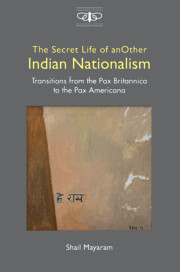 The Secret Life of AnOther Indian Nationalism
The Secret Life of AnOther Indian Nationalism Book contents
- Frontmatter
- Dedication
- Contents
- List of Figures
- List of Abbreviations
- Preface
- Acknowledgements
- Note on Transliteration
- 1 Introduction: Colonialism, Orientalism, Nationalism and the Shaping of Popular History and Religion
- 2 Orienting the Vernacular Imaginaire: James Tod and Indian Nationalism
- 3 War and Violence in Savarkar’s View of Indian History
- 4 Nationalism and Time: The Vishva Hindu Parishad’s Fantasmagorical History
- 5 Transforming Hinduism: The Politics of Vishva Hindu Parishad Conversion
- 6 AnOther History of Religion
- 7 Sushila Rawat, the Healer of Husain Tekri: Myth and Medical Pluralism as Resistance to Hindutva
- Index
5 - Transforming Hinduism: The Politics of Vishva Hindu Parishad Conversion
Published online by Cambridge University Press: 11 February 2022
- Frontmatter
- Dedication
- Contents
- List of Figures
- List of Abbreviations
- Preface
- Acknowledgements
- Note on Transliteration
- 1 Introduction: Colonialism, Orientalism, Nationalism and the Shaping of Popular History and Religion
- 2 Orienting the Vernacular Imaginaire: James Tod and Indian Nationalism
- 3 War and Violence in Savarkar’s View of Indian History
- 4 Nationalism and Time: The Vishva Hindu Parishad’s Fantasmagorical History
- 5 Transforming Hinduism: The Politics of Vishva Hindu Parishad Conversion
- 6 AnOther History of Religion
- 7 Sushila Rawat, the Healer of Husain Tekri: Myth and Medical Pluralism as Resistance to Hindutva
- Index
Summary
Around the mid-1980s when the Vishva Hindu Parishad's (henceforth VHP) Paravartan was at its height, forty-six cases of image breaking occurred in Beawar. They were widely reported in the local and national press. According to the police, these were primarily cases of Muslims breaking Hindu icons and were popularly represented as having been caused by Muslim fanatics. Indeed, I myself had presumed, when I began my fieldwork in the area, that certain local Merat Muslims were responsible for the mass image breaking. There seemed to be an irrefutable logic at work here, for who else would break ‘Hindu’ icons? The ‘image-breaking’ was explained by their new Islamic identity that had become particularly prominent in recent decades as a consequence of the work of several Muslim educational and reformist organisations. The investigations in some of the villages where the imagebreaking episodes were concentrated, such as Nimgarh and Chang, brought home instead a drastically different world of popular religious practice and of a lived Hinduism, in the making and transmission of which the Merat Muslims had played an important role and, indeed, continued to do so.
As detailed in the previous chapter, after a major campaign of two decades, the VHP claimed to have made the largest number of conversions in the country in Beawar, a subdivision of Ajmer in northwestern India. According to data published after the first decade in 1991, 1,03,025 persons from 900 villages and 19,460 families had been subject to Paravartan, or had been ‘reconverted’. Umashankar Sharma, the architect of the Beawar conversion drive launched another in the adjacent locale of Udaipur in February 2014 and claimed to have converted 40,000. This chapter explores the Paravartan campaign and the disputes relating to conversion and the politics of icon vandalism that arose in its wake. The ethnography of Hindu nationalism is used as a point of entry into the transformation of Hinduism that is under way. The VHP claims to promote Hindutva, or Hindu-ness, that is, the quality of being a Hindu. But the project of social and religious reform and the accompanying purging of ‘social evils’ associated with the Paravartan campaign are changing conceptions of what it means to be a Hindu. The argument that follows will attempt to show how a canonical closure with respect to Hinduism is being attempted.
- Type
- Chapter
- Information
- The Secret Life of AnOther Indian NationalismTransitions from the Pax Britannica to the Pax Americana, pp. 152 - 190Publisher: Cambridge University PressPrint publication year: 2022


